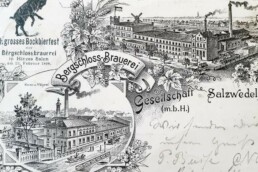Salzwedel city history
The name “Salzwedel” was documented for the first time in 1112 when Emperor Heinrich V laid siege to a castle, which presumably was built to protect a shallow pathway though the river Jeetze. The first mention of Salzwedel as a Civitas (settlement) dates back to 1233. „Soltwidele“ describes a place where salt was waded through shallow waters. Salzwedel was located along the salt road from Lüneburg to Magdeburg. (Source: Deutsche Fachwerkstraße e.V.). Already in 1247 Salzwedel Neustadt was founded as a planned extension Northeast of the Altstadt (Old town) of Salzwedel. Both cities coexisted for centuries in a conflict-ridden relationship. Unification of New and Old town succeeded finally in 1713 by mandate of a state principal.
From 1263 until 1518 Salzwedel was a member of the German Hanse . In 1263 the Council of Lübeck informed the Aldermann in Visby on Gotland, that Salzwedel had been inducted into the Hanse. In 1248 custom rates for trade between Salzwedel and Hamburg and Salzwedel and Lübeck were agreed. The wealth of the era is still manifest today in the city fortifications, in the main churches of the old town (St. Mary’s) and the new town (St. Catharine’s) and in the Mönchskirche (monk’s church), which today serves as a conference center.
Extended powers on the state level since the 15th century worked against the independence of the cities. The principal of Brandenburg, Kurfürst Johann Cicero, defeated the so-called Bierziese uprising in 1488. The city lost the right to run a judicial court, the right to freely choose city counsellors, the right to declare statutes and the right to enter alliances. In 1518 Salzwedel left the Hanse.

In the late 16th and 17th century major constructions were built such as the Probstei in 1578, the Latin school of Salzwedel Neustadt in 1579, the Salzwedel Neustadt town hall (later hotel “Schwarzer Adler”) with the town hall tower in 1585 or the Neustädter Kaufhaus (Neustadt shopping center) between 1608 and 1619. It burnt down in 1895. Only a few richly ornamented half timber houses have been preserved to this day such as the Ritterhaus (Radestraße 9), the “Adam- and -Eve-Portal” (Schmiedestraße 27) or the Brauhaus (Brewery, Altperverstraße 20). They date back to the 16th and 17th centuries.

In the thirty-years’ war (1618 – 1648) Salzwedel was spared of sieges, arson and looting, but suffered from being forced to provide room and board to marauding armies and to satisfy financial demands or various warlords.
The 18th century was characterized by the emergence of Salzwedel as one unified city. In 1744 the Latin schools of Old town and New town were unified. In 1763 the marksmens’ guilds of both towns were merged. In 1757 French troups occupied Salzwedel briefly. Until 1807 middle-age law prevailed: Salzwedel had an independent legal code and was head of a small family of towns. From 1807 to 1813 Salzwedel was part of the kingdom of Westphalia. Salzwedel became a district capital in the Elbedepartement and assumed for the first time greater regional responsibility.
The 19th century was characterized by economic changes. The kingdom of Westphalia proclaimed the freedom of private business. This marked the end of the guilds which had strangled economic development by stifling competition. Industrialization came late to Salzwedel. Textile production thus decreased significantly. Examples of successful industrialization were the bone processing plant of Neukranz in 1836, which evolved into a chemical plant, the iron casting plant (Loewesche Eisengießerei) in 1876, which evolved into a pump factory, the sugar plant in 1892 and the Bergschloss Brewery in 1897. In 1870 the first train line was built between Salzwedel and Stendal. In 1873 the tracks were extended to Uelzen. In 1876 electricity was first used in Salzwedel. In 1893 the city gas works were opened. In 1909 a new sewage system started operation, which completed the central water system.
The Bergschloss-Brewery is an example of industrialization in Salzwedel. This post card was printed in 1898.

The 20th century was marred by the world wars, the end of feudalism, the erection of totalitarian systems on German soil and eventually by the restoration of democracy and the rule of law. Salzwedel voted by majority and early for the national socialist regime. (Source: Oliver Schmiedl, https://lpb.sachsen-anhalt.de/online-angebote/campuspublik/die-machtuebernahme-der-nationalsozialisten-in-der-altmark.) The Jewish population was bullied, expelled and mostly murdered in concentration camps far away. In February 1945 an Allied bombing raid left 300 dead and damaged the main station substantially. Salzwedel was spared from other major destruction during the second world war. After the end of the war, German refugees came to Salzwedel. On December 31st, 1948, the city counted 25 000 inhabitants, of which 8 000 were German refugees. Soon afterwards Salzwedel found herself in the intra-German border zone.

In 1968 natural gas exploitation started. In the beginning of the 1990s the large government owned conglomerates closed. Today’s economy is centered around gas exploitation and around mid-sized companies in the production sector incl. craftsmen and building contractors, the retail and service sector and the agricultural sector. Salzwedel is a Kreisstadt, i.e. is home of the provincial administration of Altmarkkreis Salzwedel. It is a so-called medium-size-center of the state of Sachsen-Anhalt.
The town hall tower in Salzwedel Neustadt.

Source: Hanseatic city of Salzwedel
